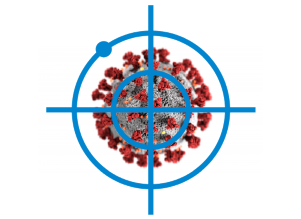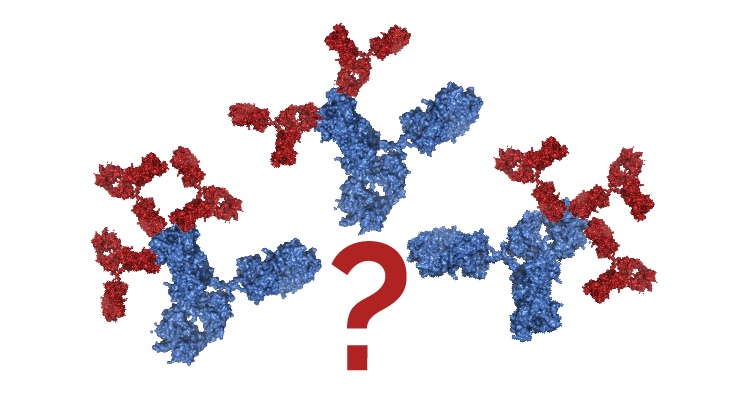Post written by Simon L. Goodman, D.Phil.
With no foreseeable safe or effective therapy or vaccine against SARS-CoV-2, extensive population testing and quarantine are amongst the few scientifically rational means of protecting people and monitoring the pandemic. To date (April 26, 2020) only 26.6 million tests for infection have been performed worldwide, with 3 million positives reported (1) by 129 of 195 countries. Cases of infection were confirmed predominantly via nucleic acid amplification tests for viral RNA. Current antibody-based serological tests are qualitative, and poorly validated. But there is little doubt that during epidemic and endemic infection, testing and obligate retesting will likely involve many 100s of millions of samples.
There are currently no validated US Food and Drug Administration (FDA)-approved diagnostic assays for SARS-CoV-2 or anti-SARS-CoV-2 antibodies in patient samples, but tests can receive emergency use authorization (EUA) (2). The lack of certification means that data from these tests is likely to be of lower quality than approved diagnostics, from the point of view of clinical specificity and selectivity. However, in third-world countries, rapid point-of-care tests must become available as soon as possible. To add to the difficulties that governments, the public, and healthcare providers face, there is an amoral escalating grey-market in dysfunctional serological home-test-kits (3).
Classes of virus tests
The coronavirus SARS-CoV-2 triggers a lethal and highly infectious disease, COVID-19, so rapid (minutes-to-hour) point-of-care tests are essential to reduce spread and establish the epidemiology of infection. Classical laboratory culture methods, in any event necessitating rare Biosafety Level-3 facilities, are excluded. The level of anti-SARS-CoV-2 neutralizing antibodies needed for protective immunity, and the degree and duration of protective immunity developed, if any, remain unknown. And there are no well-validated immunohistochemistry-capable anti-virus antibodies, so interstitial tissue distribution and loading remain unknown.
COVID-19 tests currently come in three classes:
1) Viral RNA amplification tests (Nucleic Acid Amplification Tests; NAAT);
2) Viral antigen tests, which are based on affinity detection methods (VADM); and
3) Serological tests, which detect any SARS-CoV-2-reactive antibodies.
Nasal, laryngeal or sputum swabs are currently accepted for tests 1) and 2), while pin-prick or venous blood is used for test 3). Swabbing is uncomfortable and exposes the sampler to virus, so a preprint suggesting detection in saliva of high viral titers by NAAT is of interest (4).
Tests 1) and 2) identify those who carry virus and may be infectious, even if asymptomatic. Test 3) identifies people whose immune systems have responded to SARS-CoV-2 exposure, including those who may have active viremia. Only NAATs and a single VADM are quantitative at present.
A 4th class of test is currently unavailable: a commercial test that accurately detects neutralizing anti-SARS-CoV-2 antibodies, would be valuable because it could identify those likely to mount a strong response to a repeated infection.
Only a combination of such tests, including a serological test in particular, will identify the prevalence and exposure of populations to the virus. However, as described below, current serological tests fall far below diagnostic standards (e.g., > 98% clinical selectivity; > 98% clinical specificity). At present, only predominantly qualitative VADM and serological tests are available. Infectivity is related to the amount of virus emitted by infected people, so routine quantitative tests might allow an accurate assessment of the progression of the pandemic.
Viral RNA detection
Automated commercial PCR and quantitative (Q-PCR) systems can rapidly detect and quantify (Q-PCR) SARS-CoV-2 RNA. However, the high-throughput machinery and expertise needed to perform the test is generally found only in a sophisticated centralized laboratory environment. Q-PCR laboratory-use only kits from 41 companies have received FDA EUAs, including those from:
- Hologix (Panther Fusion SARS-CoV-2 Assay);
- Primerdesign (COVID-19 genesig Real-Time PCR assay),
- Thermo Fisher (TaqPath COVID-19 Combo Kit),
- Roche (cobas SARS-CoV-2), and
- Cepheid (Xpert Xpress SARS-CoV-2 test).
Use of central laboratory facilities leads to slow readouts (1000-20000 samples per day). In the US, 21 laboratories have independently developed SARS-CoV-2 tests that are permitted for EUA usage as high-complexity molecular-based laboratory developed tests.
An exciting development is the use of isothermal amplification (IA) methods, which need less complex machinery and can be very fast (readout in < 15 mins). On March 27, 2020, the FDA issued an EUA for an IA system, ID NOW COVID-19 (Abbott laboratories), for rapid quantitative point-of-care use in SARS-CoV-2 detection. The system has fast sample analysis time (15 min), but low throughput.
On April 20, 2020, Baek et al. (5) reported a 15 minute, quantitative, one-tube, isothermal reverse transcription-loop-mediated isothermal amplification technique (Q-RT-LAMP) with a visual read out of phenol-red color change, possibly adaptable to microtiter plates. This could prove valuable in those many COVID-19-plagued countries lacking ready access to Q-RT-PCR technology.
Although NAATs are state-of-the-art diagnostics for SARS-CoV-2 infection, it must be noted that “…a significant portion of patients who otherwise fit the diagnosis based on clinical and chest CT findings, including many hospitalized patients, have tested negative for viral RNA.” (italics added) (6). This may include victims whose NAAT sinks below the limit of detection of Q-PCR after day 5 post infection (7).
Viral antigen detection
A number of companies provide point-of-care tests for viral antigen. These tests rely on SARS-CoV-2 antigen in patient samples being trapped by antigen-targeting antibodies on a detectable mobile phase. For a few examples:
- SD Biosensor’s lateral flow system has a well-documented limit of detection of ~2000 tissue culture infective dose / ml with 0/170 false positives specificity, but only 84% sensitivity over PCR (8) (i.e., resulting in 16% false negatives).
- Coris BioConcept’s acute-phase screening kit uses immunochromatographic colloidal gold-based dip stick technology (analogous to capture ELISA). With a sensitivity of 5000 pfu /ml, the kit has a high positive predictive value (78-100%), but sensitivity over PCR of < 86%. Both kits are reported to identify both SAR-CoV-2 and SAR-COV (vs other respiratory viruses and bacteria), and target conserved coronavirus nucleoprotein (9, 10).
- Bioeasy uses time-resolved fluorescence analysis in a similar assay system, but the sensitivity and selectivity data are not reported (11). Early phase infection was undetectable in a small sample set of urine and blood by VADM, while it could be identified in respiratory test probes (7).
The Foundation for Innovative New Diagnostics (FIND), a non-government organization, has identified some 10 (poorly validated) antigen tests marketed under the European CE label, and many tests of very dubious provenance are available on the internet.
Detecting anti-viral serological responses
Serological tests rely on detecting blood IgM and IgG antibodies, or mucus IgA and IgG, reacting with SAR-CoV-2. The FDA has noted that owing to the urgency of the situation, they “… had not reviewed or authorized (or “approved”) … (these tests)… at least not initially, and … (they)… should not be used for diagnosing or excluding active SARS-CoV-2 infection.” (italics added).
To date (April 28, 2020), 7 serological tests from 6 companies have received EUA. These are based on:
- Lateral flow colloidal gold capture rapid tests (Cellex; AutoBio Diagnostics; Chem-Bio Diagnostic Systems);
- Classical plate-ELISA based on the viral S1 spike protein (Ortho-Clinical Diagnostics);
- Dual ELISA for Covid-RBD protein + Spike protein (Mount Sinai Laboratory); or
- Magnetic bead-based automated ELISA targeting the S1 and S2 spike proteins (DiaSorin).
Many more tests have been developed and marketed in Europe, including:
- Immunochromatographic (Coris);
- Lateral flow (Bioeasy; ElabScience; HighPlusTech; Senova; SD sensor; Premier/Hangzou); and
- Classical plate-ELISA based for detection of anti-Covid-19 IgA and IgG (EuroImmun) (12).
FIND has identified over 60 CE labelled antibody tests (13). Each provider uses immobilized recombinant SARS-CoV-2 proteins to capture antibodies from blood, which are in turn captured on, or recognized by, “anti-human-IgG” and or “anti-IgM” reagents. As yet little detail of the validation of the reagents used in the tests has been published. Whether any tests will ever become FDA-approved diagnostics is still an open question. The sensitivity of these tests is reportedly 1-2 logs below that of viral NAAT, and only the EuroImmun test is semi-quantitative. For many rapid tests, the specificity and sensitivity has been challenged due to the low sample numbers, biased sampling and questionable reagents (14).
As yet only DiaSorin has claimed that their laboratory-based serological assay, detecting both S1 and S2 spike proteins of SARS-CoV-2, can preferentially detect neutralizing antibodies (15). If their claim and methodology can be independently confirmed, the use of such an antibody combination in a rapid test kit may be a valuable step towards disease control.
Though many companies are now offering antibody tests, the World Health Organization has yet to recognize a single appropriate serological SARS-CoV-2 assay, none have been validated sufficiently for clinical approval by the FDA, and they remain as laboratory tests. The quality of the antibodies used is currently unknown, and little data has been published on the conditions used to verify their specificity and selectivity. As we saw in our recent webcast series, such a lack of validation can cause major problems when antibodies are used as a basis to make life and death decisions. In the case of SARS-CoV-2, properly validated tests are urgently needed.
Deciphering test results
There are 4 clear stages in the progression of SARS-CoV-2 infection, which should have distinct test profiles useful for making decisions on disease spread.
1) The newly infected carry replicating virus, detectable with NAAT.
2) The infected mount a delayed adaptive immune response producing anti-viral IgM 5-10 days after infection.
3) An IgG response begins some 14 days after infection. This response may or may not produce neutralizing antibodies.
4) “Recovered” patients have a low viral titer, and so are NAAT-negative, and may or may not have detectable, and possibly neutralizing anti-SARS-CoV-2 IgG.
Thus, people at stage 1 express only viral RNA, while those at stage 2 express viral RNA and anti-SARS-CoV-2 IgM and, later, IgA. At stage 3, the infected may not express viral RNA and may have SARS-CoV-2 IgG, while those at stage 4 may continue to express anti-SARS-CoV-2 IgG. The duration, strength, and possible neutralizing nature of the primary and any secondary antibody response is currently unknown.
The COVID-19 pandemic has triggered a rapid effective scientific response. Sadly, this has in general been obscured. The demand for “tests” has driven a gold-rush – resulting in a morass of point-of-care lateral-flow kits. These frequently use unvalidated polyclonal antibodies. Given the volume of tests to be performed, this will drastically lower the quality of the resulting data. The Antibody Society welcomes recent ongoing efforts to better define the performance of such kits (16), and we hope for more efforts along these lines in the coming weeks.
References
1. Foundation for Innovative New Diagnostics. FIND Covid-19 tests. Geneva: FIND; 2020. Available from: https://www.finddx.org/covid-19/test-tracker/.
2. US Food and Drug Administration. Policy for Diagnostic Tests for Coronavirus Disease-2019 during the Public Health Emergency Washington D.C.: FDA; 2020. Available from: https://www.fda.gov/regulatory-information/search-fda-guidance-documents/policy-diagnostic-tests-coronavirus-disease-2019-during-public-health-emergency.
3. Hahn SM, McMeekin JA. Coronavirus (COVID-19) Update: FDA Alerts Consumers About Unauthorized Fraudulent COVID-19 Test Kits. March 20, 2020. Available from: https://www.fda.gov/news-events/press-announcements/coronavirus-covid-19-update-fda-alerts-consumers-about-unauthorized-fraudulent-covid-19-test-kits
4. Wyllie AL, Fournier J, Casanovas-Massana A, Campbell M, Tokuyama M, Vijayakumar P, et al. Saliva is more sensitive for SARS-CoV-2 detection in COVID-19 patients than nasopharyngeal swabs. medRxiv. 2020:2020.04.16.20067835.
5. Baek YH, Um J, Antigua KJC, Park JH, Kim Y, Oh S, et al. Development of a reverse transcription-loop-mediated isothermal amplification as a rapid early-detection method for novel SARS-CoV-2. Emerg Microbes Infect. 2020:1-31.
6. Xiao SY, Wu Y, Liu H. Evolving status of the 2019 novel coronavirus infection: Proposal of conventional serologic assays for disease diagnosis and infection monitoring. J Med Virol. 2020;92(5):464-7. Available from: https://onlinelibrary.wiley.com/doi/full/10.1002/jmv.25702
7. Woelfel R, Corman VM, Guggemos W, Seilmaier M, Zange S, Mueller MA, et al. Clinical presentation and virological assessment of hospitalized cases of coronavirus disease 2019 in a travel-associated transmission cluster. Available from: medRxiv. 2020:2020.03.05.20030502.
8. SD Biosensor. STANDARD Q COVID-19 Ag 2020. Available from: http://www.sdbiosensor.com/xe/product/7672.
9. BioConcept C. COVID-19 Ag Respi-Strip [Product insert]. B – 5032 Gembloux, Belgium: Coris BioConcepts; 2020 [updated 8th April 2020]. Available from: https://www.corisbio.com/Products/Human-Field/Covid-19.php.
10. Mousavizadeh L, Ghasemi S. Genotype and phenotype of COVID-19: Their roles in pathogenesis. J Microbiol Immunol Infect. 2020. Available from: https://doi.org/10.1016/j.jmii.2020.03.022
11. Bioeasy. 2019-nCovIgG/IgM GICA rapid test kit 2020. Available from: http://en.bioeasy.com.tr/bioeasy-novel-coronavirus-2019-ncov-test-kits/.
12. EuroImmun. SARS-CoV-2 test systems from EUROIMMUN [Supplier web site]. Lubeck: EuroImmun; 2020. Available from: https://www.coronavirus-diagnostics.com/.
13. European Centre for Disease Prevention and Control. An overview of the rapid test situation for COVID-19 diagnosis in the EU/EEA Stockholm: ECDC; 2020. Available at: https://www.ecdc.europa.eu/sites/default/files/documents/Overview-rapid-test-situation-for-COVID-19-diagnosis-EU-EEA.pdf
14. Vogel G. First antibody surveys draw fire for quality, bias. Science. 2020;368(6489):350-1. Available at: https://science.sciencemag.org/content/368/6489/350.
15. Walls AC, Park YJ, Tortorici MA, Wall A, McGuire AT, Veesler D. Structure, Function, and Antigenicity of the SARS-CoV-2 Spike Glycoprotein. Cell. 2020;181(2):281-92 e6. Available at: https://www.sciencedirect.com/science/article/pii/S0092867420302622.
16. Whitman JD, Hyatt J, Mowery CT, Shy BS. Test performance evaluation of SARS-CoV-2 serological assays [Assay analysis Lateral flow tests]. UCSF Harvard consortium: University of California, San Francisco; 2020. Available from: https://covidtestingproject.org/.




